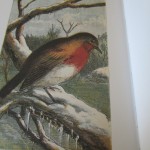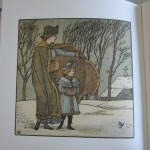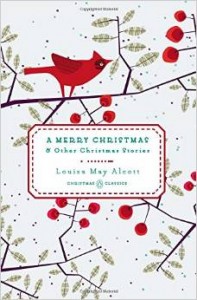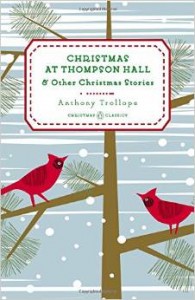A Tale of Two Covers
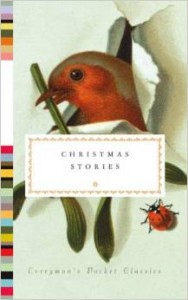 Two Days Until Christmas
Two Days Until Christmas
Christmas Stories – Everyman’s Pocket Classics
I picked this up years ago at the library book sale – attracted by the pretty cover and because I’m fond of the Everyman’s editions, so handsomely done and always with sewn-in ribbon bookmarks (I’m such a sucker for those). These small volumes always have this quote on their frontpiece:
Everyman, I will go with thee and be thy guide, in thy most need to go by thy side.
They really “get” bibliophiles and our most needs to always have a book by our side.
Christmas Stories is a treasury of short fiction by great writers of the past two centuries—including Dickens and Tolstoy to John Updike and Alice Munro. As a literary subject, Christmas has inspired everything from intimate domestic dramas to fanciful flights of the imagination, and the full range of its expression is represented in this wonderfully engaging anthology.
Admittedly, until this year I had only read a the first few stories – all Christmas classics, O’Henry, Dickens and Willa Cather’s delightful The Burglar’s Christmas (I never miss a chance to re-read that one) but last night I delved into the back of this collection and read two short stories that left me really quite depressed. One by Richard Ford about a dispirited dysfunctional family on a ski vacation and then Alice Munro uses two workers to deliver a character study as they dismember turkeys at a slaughterhouse Ugh. I had to make a cup of sleepytime tea just to get the bad taste out of my mouth.
So, I’m putting this charming looking book on trial, and will read a few more to determine its fate as a coveted member of my Christmas Books Collection.
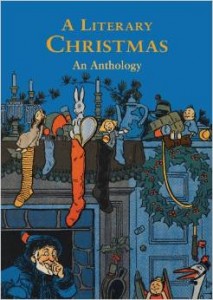 A Literary Christmas – An Anthology from The British Library
A Literary Christmas – An Anthology from The British Library
From the fly leaf: A Literary Christmas is a seasonal compendium that collects poems, short stories, and prose by some of the greatest poets and writers in the English language. Like Charles Dickens’s Ghosts of Christmas Past and Present, the selections featured here are representative of times old and new. Readers will enjoy a convivial Christmas Day with Samuel Pepys, Anthony Trollope, George Eliot, and Nancy Mitford; venture out into the snow in the company of Jane Austen, Henry James, and Charles Dickens’s ever-popular Mr. Pickwick; and warm up by the fire with the seasonal tales of Dylan Thomas, Kenneth Grahame, and Oscar Wilde.
This awful cover is proof that I shouldn’t be lured by a pretty one (see above) — this is a joyful collection of stories, poems, carols, essays and illustrations. The editors cleverly organized the book in such categories as “Before Christmas”, “Snow and Ice” and “Christmas Fare”.
Look, here’s Samuel Pepys Christmas Day diary entry from 1662 and a treatise on a doctor-prescribed diet just before Christmas by P.G. Wodehouse. An except from Cider with Rosie (an English coming of age classic) and Washington Irving’s description of a grand Christmas dinner. Something for everyone in this lovely book.
Here’s a sample of some of the illustrations within (click to enlarge):
So the sage advice of don’t judge a book by its cover stands true.
BUSTED Uh Oh –both volumes include Trollope Christmas stories –despite my claims from this post. However, we shall speak no further on this subject.
Christmas with Alcott and Trollope
Five Days Until Christmas
The newest additions to my Christmas library – purchased for myself at The Booksmith, one of my favorite San Francisco independent bookstores. This store has intriguing events, one of which I have yet to attend — their six times a year $25 open bar & book swap (tempting, oh so tempting – Melinda you in?).
I know quite a shock, me buying more books — but let’s change the subject…shall we?
I don’t own either of these story collections (see? I needed these) and while I know I’ll enjoy Louise May Alcott, I’ve always had trouble reading Trollope. Maybe this small volume will get me over the Trollope hurdle and onto his other works. My grandfather’s book collection includes Barchester Towers and it’s such a lovely edition I would so like to get past the first chapter. Maybe now I will. (Can we say rationalization?)
These are sublime little volumes — beautifully designed—with foil-stamped jackets, decorative endpapers, and vintage nameplates.
They’re part of Penguin’s Christmas Classics series, they’ll publish only a few each year…here’s this year’s list.
- A Christmas Carol by Charles Dickens
- Christmas at Thompson Hall: And Other Christmas Stories by Anthony Trollope
- A Merry Christmas: And Other Christmas Stories by Louisa May Alcott
- The Night Before Christmas by Nikolai Gogol
- The Nutcracker by E. T. A. Hoffmann
I’m proud I limited myself to only two from the list. I came very close to also owning the Nutcracker, but I pulled my errant hand back just in time.
Dickens, of course
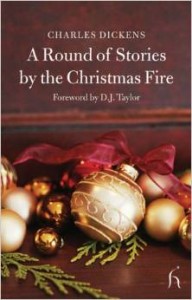 6 Days Until Christmas
6 Days Until Christmas
A Round of Stories by the Christmas Fire by Charles Dickens
From the frontpiece:
Published in its entirety for the first time since 1852, this shining collection of Christmas tales was originally selected by Charles Dickens for his periodical “Household Words”. Each story varies in theme and tone, with scenes of romance, theft, justice, and heart-warming family reunions set alongside haunting tales and chilling ghost stories, while topics addressed range from the meaning of Christmas to disability and race. Contributing authors include Elizabeth Gaskell, Edmund Saul Dixon, Edmund Oliver, and of course Dickens himself, making this a brilliant example of Victorian storytelling and an insightful reflection on the holiday season during the 19th century.
################################################
Dickens was editor of Household Words – a very popular Victorian periodical, with sales at the time in the six figures (wow!). Dickens often commissioned his favorite authors to impersonate an event and write short story installments from different perspectives. In these stories (published as a 1852 Christmas supplement issue) Dickens had each of the authors take on an imaginary role in an extended Victorian family and its servants. Utilizing these various voices from very different classes, the tales are presented in the age old tradition of round-robin style before a roaring fire – sometimes the characters even address one another (which I found delightful).
I will say this is no Hallmark card and these tales are often quite un-Christmasy — from an accidental murder, to ghosts and the mistreatment of a maid. But this being Dickens – there is always uplift and hope within each tale and the storyline, despite being written by different authors, compels the reader to the next narrator.
Because this is the Victorian period (and the often pedantic Dickens), the writing can be a rough road for a modern reader. As in this example from the beginning of Dickens first story entry:
He was very reluctant to take precedence of so many respected members of the family, by beginning the round of stories they were to relate as they sat in a goodly circle by the Christmas fire…
I promise you’ll eventually get in the cadence of the writing but it does take some concentration and perseverance. It is well worth the effort. This is a wonderful view into the Victorian era – where life was hard but hope and charity were steadfast.
The Christmas Letters by Lee Smith

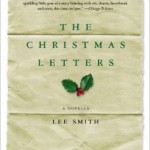 8 Days Until Christmas
8 Days Until Christmas
By now you know of my fondness for epistolary novels and when it involves Christmas letters – well, all the more enticing. I’ve read this book almost every year since I received it as a gift from my friend Jane. Turns out my copy (left) is a first edition and the cover was changed with subsequent editions (right).
Lee Smith is a Southern writer, most famous for Fair and Tender Ladies (add that one to your list) who writes compelling family sagas without slobbering or being sticky sweet.
This novella tells the life stories of several generations of women through their family letters at Christmas. The women write of their struggles to cope with the hardships each generation is given–a husband off in WWII, a damaged Viet Nam veteran, divorce, loss of a parent, a child leaving home and the fate of being handed a life you can’t fathom but try to accept.
Not your typical “feel good” Christmas story – this is real life, messy and unforgiving, but still filled with love and family ties. And it includes recipes – each woman shares what she has tried cooking and writes out how she prepared the dish. The dishes range in time period, a simple custard during WWII to the novelty of processed food in the sixties, and then a back-to-the-earth vegetarian recipe. Nicely, the talk of food in the letters set the tone without overpowering the story — when the Southern grandmother takes her first bite of a bagel, she exclaims “Whoever thinks this is good has never had a biscuit!”.
The ending leaves a big question making me wonder if Ms. Lee had plans to continue the saga – but sadly there have been no sequels.
Excerpted from the back cover:
Dear Friends,
Like me, you probably get Christmas letters every year. I read every word and save every letter. Because every Christmas letter is the story of a life, and what story can be more interesting than the story of our lives? Often, it is the story of an entire family. But you also have to read between the lines with Christmas letters. Sometimes, what is not said is even more important than what is on the page.
I wrote this little book for the same reason I write to my friends and relatives every holiday–Christmas letters give us a chance to remember and celebrate who we are.
With warmest greetings, Lee Smith
The book is a lovely quiet holiday read, and it holds its standing as one of my favorite Christmas books to re-read each season, to remind me of what I hold dear about the holidays, the embracing of loved ones, good cheer and charity.
Comme le vent (Like the wind)…
I read like the wind — two books over the weekend. Admittedly, they were quite short books, but I seem to have reclaimed my reading mojo.
Both current French fiction with wry Gallic style and observations. (Sorry to admit, I read them translated to English – my French is nowhere near “reading novels” proficient)
The President’s Hat by Antoine Laurain
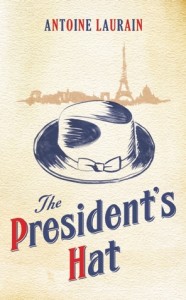 Dining alone in an elegant Parisian brasserie, accountant Daniel Mercier can hardly believe his eyes when President François Mitterrand sits down to eat at the table next to him.
Dining alone in an elegant Parisian brasserie, accountant Daniel Mercier can hardly believe his eyes when President François Mitterrand sits down to eat at the table next to him.
Daniel’s thrill at being in such close proximity to the most powerful man in the land persists even after the presidential party has gone, which is when he discovers that Mitterrand’s black felt hat has been left behind.
After a few moments’ soul-searching, Daniel decides to keep the hat as a souvenir of an extraordinary evening. It’s a perfect fit, and as he leaves the restaurant Daniel begins to feel somehow … different.
A french fairy tale of sorts, set during the Mitterrand years (1980s) tells of a hat lost, found and lost again and its magical powers of transformation. This is a fast-paced and whimsical story chock full of French perspective.
Voila – here is President Mitterrand’s hat accidentally left behind for a hapless accountant to snitch and wear out of the restaurant. The hat brings the new wearer confidence and recognition and when he leaves it behind on a train, it is found and worn by a woman needing courage and hope. The hat brings each new finder just what they need to change their lives. Somewhat improbably, all the characters connect in the latter half of the book, and the epilogue cunningly ties everything together and back to the President.
Layered over and under this simple tale is Monsieur Laurain’s fully observed French society of the 1980’s. You are there — when France was still Starbucks free and regular workers could afford a lunch of oysters and crisp white wine. Decades-old class distinctions were just starting to crumble and new political views were taking hold. Neighborhood bistros have not yet evolved into swanky restaurants and an answering machine is new technology.
There are inside observations that will be obvious to the native French but have to be teased out if you’re like me, an unaware American. Who knew that the pronunciation of Mitterrand’s name was code for a French person’s political views? Or that such serious consideration is given to a choice of perfume for both French women and men?
This novel reminded me of an O’Henry or Evelyn Waugh story but with a delightful French twist. At only 200 pages this book goes quickly – and perfect for that picky Francophile on your gift list.
#####################################################
My Wish List by Gregoire Delacourt
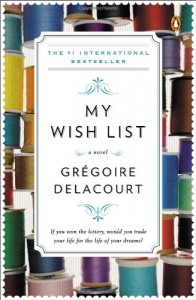 If you won the lottery, would you trade your life for the life of your dreams?
If you won the lottery, would you trade your life for the life of your dreams?
Jocelyne lives in a small town in France where she runs a fabric shop, has been married to the same man for twenty-one years, and has raised two children. She is beginning to wonder what happened to all those dreams she had when she was seventeen. Could her life have been different?
Then she wins the lottery—and suddenly finds the world at her fingertips. But she chooses not to tell anyone, not even her husband—not just yet. Without cashing the check, she begins to make a list of all the things she could do with the money. But does Jocelyne really want her life to change?
This is a sad but thoughtful novella and the author writes with cynicism and sentimentality. A study of contrasts all wrapped up in a winning-the-lottery dream.
Jocelyne is ordinary – really ordinary, but she has hopes, wishes and desires. She is married to a materialistic man, her grown children are a disappointment and her closest friends are silly twins who, unlike Jocelyne, are young, thin and desired. Out of character one day, Jocelyne buys a lottery ticket and somehow predicts to herself that she will win. Thus begin the lists – her lists of things she needs.
When she does actually win the lottery, she hides the win from everyone, doesn’t tell a soul, except her father who is in a nursing home and has a six minute memory span. Her conversations with her father about the money and what she should do, are alternately hysterical and heartbreaking.
Jocelyne fears the change and impact of such riches (18.5 million Euros). She knows her husband wants a flat screen TV, a sports car, and a fancy watch, while Jocelyne’s list includes a new shower curtain and a better reading lamp. As the novel progresses, her lists evolve to include going to a spa and a Chanel bag. She kindly starts to include things her husband would want such as every James Bond Film on DVD.
Jocelyne carries on with her life, she works in a fabric shop and has a very successful crafting blog, but her hidden lottery check is never far from her mind. Soon her lists start to include such sad items as To be told I’m beautiful…and To be envied, at last.
OK, so you think you get it – the lottery win is a metaphor for life and how things of value can’t be bought. But here’s where Monsieur Delacourt doesn’t take the easy road, he lets Jocelyne want her things as badly as her desires. Such as this passage:
“Because our needs are our little daily dreams. The little things to be done that project us into tomorrow, the day after tomorrow, the future; trivial things that we plan to buy next week allowing us to think that next week we’ll still be alive. It’s the need for a nonslip bath mat that keeps us going.”
Jocelyne is the only fully developed character, I couldn’t warm to any of the others, but she is enough to pull the novel along. The novel is told entirely in the present tense, which is a typical for modern-day French novels, and I’m happy the translator didn’t try to adapt the style for English-readers. Here’s a quote from the book that is insight into this author’s unusual writing style:
“I love words. I love long sentences, sighs that go on forever. I love it when words sometimes hide what they’re saying, or say it in a new way.”
I think M. Delacourt gets a few things wrong. Jocelyne’s husband is named Jocelyn which the author introduces slyly, (and it’s important later in the book) but I found it distracting. This male author has Jocelyne (the wife — see, confusing!) viewing her naked overweight body in the mirror and thinking it beautiful. I doubt any overweight woman would do that – maybe French women, but not this American women – perhaps I lack such evolved confidence, but it felt female-false. There is a betrayal and an strangely abrupt bittersweet ending, which I won’t spoil here.
At only 163 pages, this novella packs the import of a much longer novel, I find myself thinking about it still.
Note: The original French title was List of My Desires – which I think would have been a better English title as well.
My Wish List was provided by Penguin via NetGalley
Testament of Gideon Mack by James Robertson
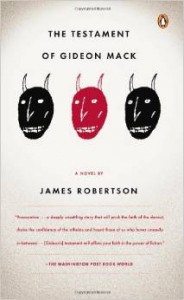 For this Throwback Thursday, I revisit a most memorable book from 2007.
For this Throwback Thursday, I revisit a most memorable book from 2007.
From the back cover: A critical success on both sides of the Atlantic, this darkly imaginative novel from Scottish author James Robertson takes a tantalizing trip into the spiritual by way of a haunting paranormal mystery. When Reverend Gideon Mack, a good minister despite his atheism, tumbles into a deep ravine called the Black Jaws, he is presumed dead. Three days later, however, he emerges bruised but alive-and insistent that his rescuer was Satan himself. Against the background of an incredulous world, Mack’s disturbing odyssey and the tortuous life that led to it create a mesmerizing meditation on faith, mortality, and the power of the unknown.
Reverend Gideon Mack, a Scottish minister who doesn’t believe in God, ends up meeting and being saved by the devil. The sudden appearance of a standing stone in the woods, visible only to him, is a chilling precursor of his encounter with the horned one.
Yet, in telling his tale, his sanity is questioned and his place in the church is threatened. Is Gideon Mack crazy or suffering from a nervous breakdown? Did what happened to him actually happen?
This is a strange, yet fascinating tale and Mr. Robertson is a masterful writer to be able to pull off such an unusual premise.
Gideon’s written account (his testament) tells the tale and is delivered into the hands of a publisher after Gideon’s sudden disappearance followed by the discovery of his body. The publisher launches an investigation into claims from Gideon’s story. The results leave the reader mystified and, in the end, left to make their own decision as to what really happened.
The novel is many layered, there is the manuscript and the narration told through a number of differing Scottish accents. Then there is the tale itself with questionable validity. And finally, there is the rich undercurrent which questions the nature of our beliefs and held truths. It leaves the reader with more questions than answers. There is even a website dedicated to the novel and its many unresolved answers and interpretations. Here.
This would be an excellent book group selection, as there are bound to be as many explanations as members of the group. The Penguin edition has a very good readers guide.
While I often skip prologues (sshh don’t tell anyone) do not skip the prologue or the epilogue in this novel – they are Mr. Robertson’s best work and vital to the storyline in The Testament of Gideon Mack.


